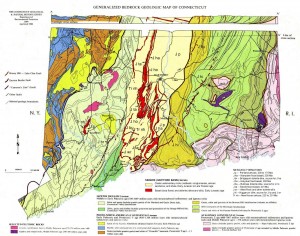More than a dozen earthquakes have rocked eastern Connecticut since January, alarming residents and raising concerns about whether a larger quake might follow.
The swarm of earthquakes occurred in the Plainfield area, which nearly borders Rhode Island, with the largest tremor measuring magnitude 3.3. Compared to more prominent natural disasters, even the strongest of this wave of Connecticut earthquakes was not terribly high in magnitude. Seismologists say that the risk of a larger earthquake that will do considerable damage remains low. Still, they stress that recent events should remind people of the need for earthquake preparedness on the East Coast.
“We’ve always been concerned about earthquakes in New England,” said Robert Williams, Central & Eastern U.S. Regional Coordinator at the United States Geological Survey. The region has had a long history of earthquakes, with the magnitude 6.0 Cape Ann quake in 1755 damaging hundreds of buildings in Boston. More recently, in 2011, a magnitude 5.8 quake rocked Virginia, causing damage estimated at more than $100 million.
Why would earthquakes occur on the East Coast, when the nearest plate boundary is in the middle of the Atlantic Ocean? The prevailing hypothesis involves old faults, areas of weakness where the Earth’s crust broke in the past.

Four hundred million years ago, when the landmasses that formed the supercontinent Pangea came together, they collided with and were pressed against each other like chunks of dough. Upon separation, the crust split apart in many different regions. Both the coming together and splitting apart left lines of weakness in the Earth’s crust. Geologists refer to these weak lines as “old faults.”
“In most cases, old fault lines will not produce earthquakes because there’s nothing stressing them, unlike active faults between tectonic plates” said Jeffrey Park, Yale professor of geology and geophysics. However, past glacial build-up in the New England area may be responsible for the recent earthquakes.
Just 20,000 years ago, 6,000 feet of ice covered New England, weighing down on and deforming the crust. Once the ice melted, the crust began the lengthy process of rebounding to its original shape. “Imagine pressing down on a foam mattress and then removing your hand,” said Maureen Long, another Yale professor of geology and geophysics. As the crust changes shape, stress builds up within it. This stress is eventually released along the old faults, producing earthquakes. Moreover, one earthquake might cause stress to build up in a different region of the crust, making subsequent tremors more likely. According to Williams, it is not unusual for swarms of earthquakes to last for months.
Even though the occurrence of a cluster of earthquakes does increase the possibility of a larger quake, Park said that the probability of an earthquake that would cause significant damage remains low. Still, both Park and Long said that the recent seismic activity shows that both the scientific community and the general population need to think about earthquake hazards — even on the East Coast where they seem like a rare or unlikely occurrence.
John Ebel, professor of earth and environmental sciences at Boston College, is leading a team of seismologists to study the Plainfield tremors. The team has deployed four portable seismic instruments to pinpoint the location of the weak tremors and to determine if the quakes line up along an old fault. By looking at the size of the fault, Ebel’s group hopes to estimate how strong a quake we should expect if a larger one does arise.
Already, Ebel’s team has found that the earthquakes are shallow from a seismological point of view, originating from less than 1.5 kilometers beneath Earth’s surface. Compared to deeper quakes of the same magnitude, shallow earthquakes have the potential to generate larger tremors and do more damage. The recent Connecticut tremors, then, show that earthquakes on the East Coast are not to be ignored.
Researchers are optimistic that increased interest in New England earthquakes will help people better understand the phenomenon and make more informed decisions.
Cover Image: A seismometer, which collects essential data on earthquakes, is buried into the ground. Image courtesy of USGS.
